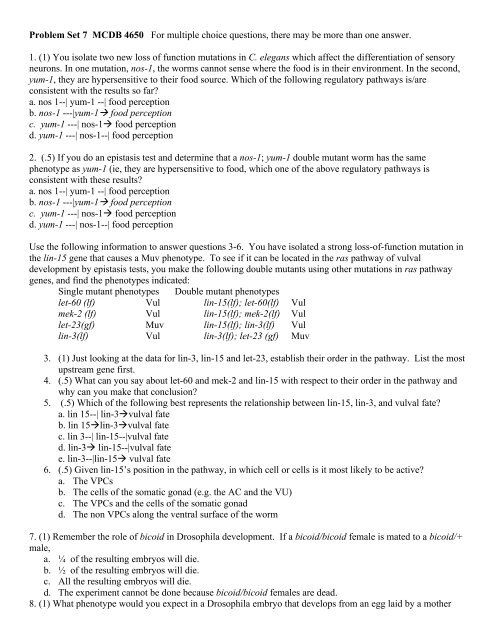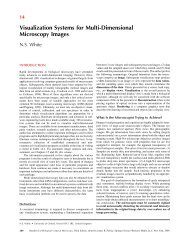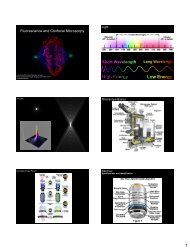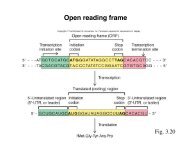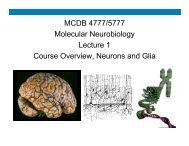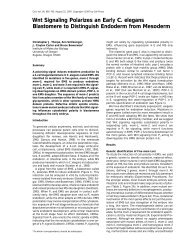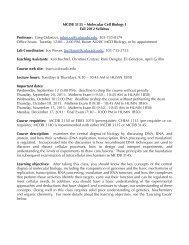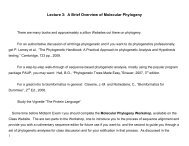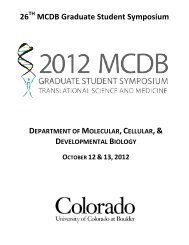Problem Set 7 due Saturday
Problem Set 7 due Saturday
Problem Set 7 due Saturday
You also want an ePaper? Increase the reach of your titles
YUMPU automatically turns print PDFs into web optimized ePapers that Google loves.
<strong>Problem</strong> <strong>Set</strong> 7 MCDB 4650 For multiple choice questions, there may be more than one answer.<br />
1. (1) You isolate two new loss of function mutations in C. elegans which affect the differentiation of sensory<br />
neurons. In one mutation, nos-1, the worms cannot sense where the food is in their environment. In the second,<br />
yum-1, they are hypersensitive to their food source. Which of the following regulatory pathways is/are<br />
consistent with the results so far?<br />
a. nos 1--| yum-1 --| food perception<br />
b. nos-1 ---|yum-1à food perception<br />
c. yum-1 ---| nos-1à food perception<br />
d. yum-1 ---| nos-1--| food perception<br />
2. (.5) If you do an epistasis test and determine that a nos-1; yum-1 double mutant worm has the same<br />
phenotype as yum-1 (ie, they are hypersensitive to food, which one of the above regulatory pathways is<br />
consistent with these results?<br />
a. nos 1--| yum-1 --| food perception<br />
b. nos-1 ---|yum-1à food perception<br />
c. yum-1 ---| nos-1à food perception<br />
d. yum-1 ---| nos-1--| food perception<br />
Use the following information to answer questions 3-6. You have isolated a strong loss-of-function mutation in<br />
the lin-15 gene that causes a Muv phenotype. To see if it can be located in the ras pathway of vulval<br />
development by epistasis tests, you make the following double mutants using other mutations in ras pathway<br />
genes, and find the phenotypes indicated:<br />
Single mutant phenotypes Double mutant phenotypes<br />
let-60 (lf) Vul lin-15(lf); let-60(lf) Vul<br />
mek-2 (lf) Vul lin-15(lf); mek-2(lf) Vul<br />
let-23(gf) Muv lin-15(lf); lin-3(lf) Vul<br />
lin-3(lf) Vul lin-3(lf); let-23 (gf) Muv<br />
3. (1) Just looking at the data for lin-3, lin-15 and let-23, establish their order in the pathway. List the most<br />
upstream gene first.<br />
4. (.5) What can you say about let-60 and mek-2 and lin-15 with respect to their order in the pathway and<br />
why can you make that conclusion?<br />
5. (.5) Which of the following best represents the relationship between lin-15, lin-3, and vulval fate?<br />
a. lin 15--| lin-3àvulval fate<br />
b. lin 15àlin-3àvulval fate<br />
c. lin 3--| lin-15--|vulval fate<br />
d. lin-3à lin-15--|vulval fate<br />
e. lin-3--|lin-15à vulval fate<br />
6. (.5) Given lin-15’s position in the pathway, in which cell or cells is it most likely to be active?<br />
a. The VPCs<br />
b. The cells of the somatic gonad (e.g. the AC and the VU)<br />
c. The VPCs and the cells of the somatic gonad<br />
d. The non VPCs along the ventral surface of the worm<br />
7. (1) Remember the role of bicoid in Drosophila development. If a bicoid/bicoid female is mated to a bicoid/+<br />
male,<br />
a. ¼ of the resulting embryos will die.<br />
b. ½ of the resulting embryos will die.<br />
c. All the resulting embryos will die.<br />
d. The experiment cannot be done because bicoid/bicoid females are dead.<br />
8. (1) What phenotype would you expect in a Drosophila embryo that develops from an egg laid by a mother
that produces no bicoid mRNA? Select all possible answers.<br />
a. the caudal protein would not be present<br />
b. the caudal protein would be uniformly distributed<br />
c. the nanos protein would not be present<br />
d. the nanos protein would be uniformly distributed<br />
e. the hunchback protein levels would be decreased<br />
Use the two diagrams below. A. shows the hunchback gene and regulatory region. B. shows where the gap<br />
proteins hunchback and giant are localized in the Drosophila embryo.<br />
9. (1) How is hunchback protein ultimately localized to the embryo in the distribution pattern shown in B?<br />
Explain the roles of bicoid(bcd) and giant in this process.<br />
A. B.<br />
10. (1) The expression of hunchback is also regulated by another transcription factor, torso (tor). Based upon<br />
the Anterior/Posterior pattern of bcd and tor concentration shown in the figure below, is tor most likely an<br />
activator or a repressor of hunchback transcription? Briefly explain.<br />
Protein<br />
Concentration<br />
Anterior<br />
torso<br />
Region of<br />
Hunchback<br />
Transcription<br />
bicoid<br />
Posterior<br />
11. (1) What would be the outcome of a loss of function mutation in tor on the distribution of Hb expression?<br />
a. Hb would expand all the way to the anterior end.<br />
b. Hb would expand further to the posterior<br />
c. Hb would no longer be expressed<br />
12. (1) The previous questions all relate to the embryonic transcription of Hunchback. Consider the following<br />
scenario. In an embryo with genotype Hb-/Hb-, from a Hb-/Hb+ mother, Hb protein is still distributed normally<br />
in the embryo up to the 14 th cell cycle. Why? (select correct answer(s))<br />
a. Normal Hb mRNA from mother is still contributed to the embryo<br />
b. Embryonically transcribed Hb mRNA is still made by the embryo, activated by bicoid<br />
c. Translational repression of Hb occurs only at the posterior, where nanos is located<br />
d. Translational repression of Hb occurs only at anterior, where caudal is located


